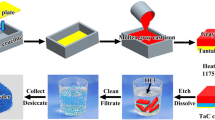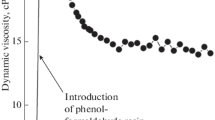Abstract
Pulsed laser ablation of bulk TaC in vacuum under a high power density was used to fabricate fine-sized tantalum carbide particles, i.e., γ-TaC1−x with varied extent of carbon deficiency and α-Ta2C surrounded by an amorphous phase of Ta-doped carbon clusters or lamellae according to X-ray and electron diffraction. The predominant γ-TaC1−x has a high x value (~0.4) and almost spherical shape when rapidly solidified as submicron-sized particulates, whereas x ~ 0.2 and facetted with occasional {111} coalescence twin when condensed as nanoparticles. The minor α-Ta2C occurred either as nanocondensates with hexagonal crystal form or as a stable epitaxial intergrowth with the γ-TaC1−x particulate having close-packed planes in parallel with the precipitation process. The γ-TaC1−x and α-Ta2C nanocondensates were also coalesced approaching a secondary relationship, i.e., [011]TaC1−x //[01\( \overline{ 1} \)0]Ta2C and (100)TaC1−x //(0001)Ta2C having a fair coincidence site lattice at the interface. The refractory materials have a bimodal minimum band gap (ca. 3.8 and 2.3 eV) for potential optocatalytic and tribology applications at high temperatures.













Similar content being viewed by others
References
A.I. Gusev, A.A. Rempel, V.N. Lipatnikov, J. Phys. Condens. Matter 8, 8277 (1996)
G. Santoro, H.B. Probst, Adv. X-ray Anal. 7, 126 (1963)
E.K. Storms, The Tantalum–Tantalum Carbide System, in The Refractory Carbides, ed. by E.K. Storms (Academic Press, New York, 1967)
A.L. Bowman, T.C. Wallace, J.L. Yarnell, R.G. Wenzel, E.K. Storms, Acta Crystallogr. 19, 6 (1965)
K. Yvon, E. Parthé, Acta Crystallogr. B 26, 149 (1970)
H. Wiesenberger, W. Lengauer, P. Ettmayer, Acta Mater. 46, 651 (1998)
A.I. Gusev, A.S. Kurlov, V.N. Lipatnikov, J. Solid State Chem. 180, 3234 (2007)
D.J. Rowcliffe, G. Thomas, Mater. Sci. Eng. 18, 231 (1975)
R.A. Morris, D. Butts, S. DiPetro, A. Craven, L. Matson, G.B. Thompson, Comparison between HIP and VPS tantalum carbides microstructure morphologies, in SAMPE 2009 Technical Conference Proceedings, Baltimore, MD, 2009 May 18–21, pp. 1–10
A. Friedrich, B. Winkler, E.A. Juarez-Arellano, L. Bayarjargal, Materials 4, 1648 (2011)
S.A. Shvab, F.F. Egorov, Sov. Powder Metall. Metal Ceram. 21, 894 (1982)
A. Krajewski, L. D’Alessio, G. De Maria, Cryst. Res. Technol. 33, 341 (1998)
N. Ahlen, M. Johnsson, M. Nygren, Thermochim. Acta 336, 111 (1999)
D.R. Lide, Handbook of Chemistry and Physics, 90th edn. (CRC Press, Boca Raton, 2009)
Y.J. Chen, J.B. Li, Q.M. Wei, H.Z. Zhai, Mater. Lett. 56, 279 (2002)
A.L. Giorgi, E.G. Szklarz, E.K. Storms, A.L. Bowman, B.T. Matthias, Phys. Rev. 125, 837 (1962)
K. Upadhyay, J.M. Yang, W.P. Hoffman, Am. Ceram. Soc. Bull. 76, 51 (1997)
K. Balani, G. Gonzalez, A. Agarwal, R. Hickman, J.S. O’Dell, S. Seal, J. Am. Ceram. Soc. 89, 1419 (2006)
L. Leclercq, M. Provost, H. Pastor, J. Grimblot, A.M. Hardy, L. Gengembre, G. Leclercq, J. Catal. 117, 371 (1989)
J.G. Choi, Appl. Catal. A 184, 189 (1999)
M. Desmaison-Brut, N. Alexandre, J. Desmaison, J. Eur. Ceram. Soc. 17, 1325 (1997)
K. Hackett, S. Verhoef, R.A. Cutler, D.K. Shetty, J. Am. Ceram. Soc. 92, 2404 (2009)
E. Olevsky, E. Khaleghi, C. Garcia, W. Bradbury, Mater. Sci. Forum 654–656, 412 (2010)
S.R. Bakshi, V. Musaramthota, D. Lahiri, V. Singh, S. Seal, A. Agarwal, Mater. Sci. Eng. A 528, 1287 (2011)
C.L. Yeh, E.W. Liu, J. Alloys Compd. 415, 66 (2006)
Q.Y. Zhang, X.X. Mei, D.Z. Yang, F.X. Chen, T.C. Ma, Y.M. Wang, F.N. Teng, Nucl. Instrum. Methods Phys. Res. B 127–128, 664 (1997)
F.E. Palomar, P. Zambrano, M.I. Gómez, R. Colás, A. Castillo, Ing. Mec. 3, 55 (2009)
R. Teghil, L. D’Alessio, M. Zaccagnino, D. Ferro, V. Marotta, G. De Maria, Appl. Surf. Sci. 173, 233 (2001)
R. Teghil, A. De Bonis, A. Galasso, P. Villani, A. Santagata, Appl. Surf. Sci. 254, 1220 (2007)
D.B. Chrisey, G.K. Hubler (eds.), Pulsed Laser Deposition of Thin Films (Wiley-Interscience, Hoboken, 1994)
R. Eason (ed.), Pulsed Laser Deposition of Thin Films: Applications-Led Growth of Functional Materials (Wiley-Interscience, Hoboken, 2007)
V. Valvoda, Phys. Status Solidi (a) 64, 133 (1981)
R. Morris, D. Butts, P.A. Shade, G.B. Thompson, Microsc. Soc. Am. 16, 1882 (2010)
K.J. Cai, Y. Zheng, P. Shen, S. Chen, CrystEngComm 16, 5466 (2014)
Y. Wang, D.C. Alsmeyer, R.L. McCreery, Chem. Mater. 2, 557 (1990)
A.C. Ferrari, J. Robertson, Philos. Trans. R. Soc. Lond. Ser. A 362, 2477 (2004)
M.N.R. Ashfold, F. Claeyssens, G.M. Fuge, S.J. Henley, Chem. Soc. Rev. 33, 23 (2004)
L.V. Zhigilei, B.J. Garrison, J. Appl. Phys. 88, 1281 (2000)
A. Vogel, V. Venugopalan, Chem. Rev. 103, 577 (2003)
B.N. Chichkov, C. Momma, S. Nolte, F. Von Alvensleben, A. Tunnerman, Appl. Phys. A 63, 109 (1996)
N.B. Dahotre, S.P. Harimkar, Laser Fabrication and Machining of Materials (Springer, New York, 2008)
G.W. Yang, Prog. Mater. Sci. 52, 648 (2007)
P.E. Dyer, A. Issa, P.H. Key, Appl. Phys. Lett. 57, 186 (1990)
R. Fedosejevs, F. Gobet, F. Dorchies, C. Fourment, F. Hannachi, M.M. Aléonard, G. Claverie, M.Gerbaux, G. Malka, J.N. Scheurer, M. Tarisien, V. Meot, P. Morel, B. Liesfeld, L. Robson, F. Blasco, D. Descamps, G. Schurtz, Ph. Nicolai, V. Tikhonchuk, 32nd EPS Conference on Plasma Phys. Tarragona, ECA, vol. 29C, P-1.152 (2005)
D. Bäuerle, Laser Processing and Chemistry (Springer, Berlin, 2000)
R. Teghil, L. D’Alessio, G. De Maria, D. Ferro, Appl. Surf. Sci. 86, 190 (1995)
M. von Allmen, A. Blatter, Laser-Beam Interactions with Materials (Springer, New York, 1994)
V. Mazurovsky, M. Zinigrad, L. Leontiev, V. Lisin, Carbide formation during crystallization upon welding, in Proceedings of the Third International Conference on Mathematical Modeling and Computer Simulation of Material Technologies, Ariel, Israel, 2004, pp. 3/126-134
H. Wilhelm, M. Lelaurain, E. McRae, B. Humbert, J. Appl. Phys. 84, 6552 (1998)
C. Pan, S.Y. Chen, P. Shen, J. Phy. Chem. B 110, 24340 (2006)
Acknowledgments
This work was supported by the Center for Nanoscience and Nanotechnology at NSYSU and the Ministry of Science and Technology, ROC. We thank anonymous referee for constructive comments.
Author information
Authors and Affiliations
Corresponding author
Electronic supplementary material
Below is the link to the electronic supplementary material.
Appendices
Appendix 1
See Fig. 14.
Ta–C phase diagram [1]
Appendix 2
See Fig. 15.
TEM lattice image magnified from the inset in Fig. 10a showing that the γ-TaC1−x core has the faceted surface parallel to the adjoined turbostratic graphene layers developing from the amorphous carbon (a-C) shell
Appendix 3: Gaseous phase and liquid droplet formation by nanosecond (ns) laser pulses
For the ablation of the ns laser, the material ejection is likely to be dominated by thermal processes [37]. The laser pulse duration, in these applications, is typically shorter than the time of dissipation of the absorbed laser energy by the thermal conduction, the condition that is commonly referred to as thermal confinement [38, 39]. As a result, the absorbing material can be over-heated much beyond the boiling temperature, turning a normal surface evaporation at low laser fluences into an explosive vaporization, or phase explosion, at higher fluences. Theoretical predicts [38] and laser ablation experiments [40] indicated that phase explosion results in a spontaneous decomposition of the ejected plume into a two-phase system of gaseous phase and liquid droplets.
During the ns laser ablating, photons can couple with both electronic and vibrational modes of the target material, and furthermore, the electron–electron coupling results in an immediate rise in the electron temperature and eventual vaporization of the transiently heated target [30]. When the laser power density becomes sufficiently high (>105–108 W/cm2), the vaporization starts, and the evaporated material (vapor atoms) will expand [41]. Then, the vapor plume and background gas interact each other, yielding the confinement of the plume, whereas the background gas is pushed further away from the solid target. Since the temperature in the vapor plume can rise to much high values, a plasma plume will be generated during the front part of the incident laser pulse irradiating the solid target [30]. The plasma plume excitation and ionization are mainly a result of the multiphoton absorption, ionization, and inverse-Brehmsstrahlung absorption in the gaseous phase induced by the laser pulse [39]. Therefore, the plasma plume consists of clusters, molecules, atoms, ions, and electrons from the target solid [30, 41, 42].
Appendix 4
See Fig. 16.
Standard Gibbs free energy (ΔG o, kJ/mol) of carbide-formation reactions as a function of temperature up to ca. 1600 K for TiC, TaC, and Ta2C (solid lines after Ref. [48]) having extrapolation (dash line) intersection at ca. 3000 K for TiC and TaC (cf. text)
Rights and permissions
About this article
Cite this article
Lin, S.S., Shen, P. & Chen, S.Y. Laser ablation synthesis of tantalum carbide particles with specific phase assemblage and special interface. Appl. Phys. A 120, 75–88 (2015). https://doi.org/10.1007/s00339-015-9171-7
Received:
Accepted:
Published:
Issue Date:
DOI: https://doi.org/10.1007/s00339-015-9171-7







